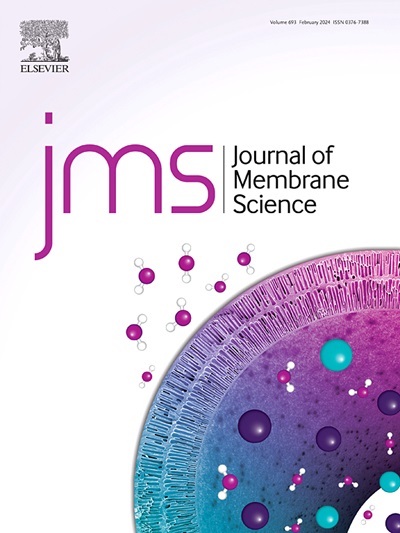氟化β-CD-MOF强化2-苯乙醇混合基质膜的渗透汽化分离
IF 8.4
1区 工程技术
Q1 ENGINEERING, CHEMICAL
引用次数: 0
摘要
β-环糊精金属有机骨架(β-CD-MOF)是由β-环糊精与钾离子配位形成的多孔晶体材料,可以显著提高混合基质膜(MMMs)的渗透蒸发分离性能。然而,由于缺乏亲和位点,实现具有高2-苯乙醇(2-PE)渗透蒸发分离性能的MMMs面临挑战。本文用3-甘基氧基丙基三甲氧基硅烷(KH560)修饰β-CD-MOF,制备了KH560功能化的β-CD-MOF (K-βMOF)。随后,通过K-βMOF的环氧基与1,4-二(4-氨基-2-三氟甲基苯氧基)苯的胺基之间的开环反应,制备了氟化β-CD-MOF (F-K -βMOF)。然后,将F-K -βMOF掺入PDMS基质中制备了具有优异2- pe渗透汽化分离性能的MMMs,总通量为1226 g m−2 h−1,分离系数为31.83,渗透汽化分离指数为37807 g m−2 h−1。这些值分别是纯PDMS膜的1.48、2.67和4.23倍,是含β-CD-MOF的MMMs膜的1.29、1.74和2.23倍。这是因为F-K -βMOF中的-CF3基团和苯环通过氢键、亲疏水和π-π相互作用增强了对2-PE的亲和力。当2-PE水溶液中麦芽糖醇的浓度增加到1200 ppm时,2-PE的通量和分离系数分别下降了39%和37%。2-PE的分离因子从31降低到20,但仍高于麦芽糖醇,表明MMMs具有高效的分子识别能力。此外,mm在168小时的测试中表现出优异的耐久性,突出了2-PE分离在工业应用中的巨大潜力。本文章由计算机程序翻译,如有差异,请以英文原文为准。

Fluorinated β-CD-MOF strengthened 2-phenylethanol pervaporation separation of mixed matrix membranes
Beta-cyclodextrin metal-organic framework (β-CD-MOF) is porous crystalline material formed by coordinating β-cyclodextrin with potassium ion, which can significantly enhance the pervaporation separation performance of mixed matrix membranes (MMMs). However, achieving MMMs with high 2-phenylethanol (2-PE) pervaporation separation performance poses challenges due to the lack of affinity sites. Herein, β-CD-MOF was modified with 3-glycidoxypropyltrimethoxysilane (KH560) to prepare KH560-functionized β-CD-MOF (K-βMOF). Subsequently, fluorinated β-CD-MOF (F–K-βMOF) was prepared via a ring-opening reaction between the epoxy groups of K-βMOF and amine groups of 1,4-bis(4-amino-2-trifluoromethylphenoxy) benzene. Then, MMMs were fabricated by incorporating F–K-βMOF into a PDMS matrix, which exhibited excellent 2-PE pervaporation separation performance, achieving a total flux of 1226 g m−2 h−1, a separation factor of 31.83, and a pervaporation separation index of 37807 g m−2 h−1. These values were 1.48, 2.67, and 4.23 times higher than those of the pure PDMS membrane, and 1.29, 1.74, and 2.23 times higher than those of MMMs containing β-CD-MOF, respectively. This is because –CF3 groups and benzene ring in F–K-βMOF enhance the affinity for 2-PE through hydrogen bonding, hydrophilic-hydrophobic and π-π interactions. When the concentration of maltol in the 2-PE aqueous solution increased to 1200 ppm, the flux and separation factor of 2-PE decreased by 39 % and 37 %, respectively. The separation factor of 2-PE decreased from 31 to 20, which was still higher than that of maltol, indicating that MMMs exhibited efficient molecular recognition capability. Furthermore, MMMs exhibited exceptional durability during 168 h testing, highlighting a great potential for 2-PE separation in industrial application.
求助全文
通过发布文献求助,成功后即可免费获取论文全文。
去求助
来源期刊

Journal of Membrane Science
工程技术-高分子科学
CiteScore
17.10
自引率
17.90%
发文量
1031
审稿时长
2.5 months
期刊介绍:
The Journal of Membrane Science is a publication that focuses on membrane systems and is aimed at academic and industrial chemists, chemical engineers, materials scientists, and membranologists. It publishes original research and reviews on various aspects of membrane transport, membrane formation/structure, fouling, module/process design, and processes/applications. The journal primarily focuses on the structure, function, and performance of non-biological membranes but also includes papers that relate to biological membranes. The Journal of Membrane Science publishes Full Text Papers, State-of-the-Art Reviews, Letters to the Editor, and Perspectives.
 求助内容:
求助内容: 应助结果提醒方式:
应助结果提醒方式:


